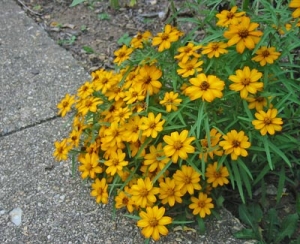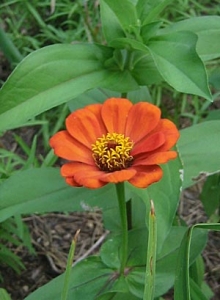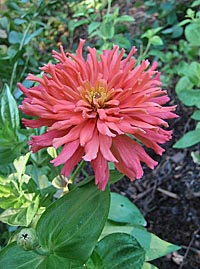Plants We Love: Zinnias

Zinnias come in a range of colors
By Marsha Goldberg & Ray Novitske,
Fairfax Master Gardeners
Welcome to our newest regular feature, which we call Plants We Love. For its content, we poll master gardeners and ask them to tell us about their favorite plants, especially those that would appeal to beginning and intermediate gardeners for their easy care and good looks. We hope that these recommendations will help you make wise choices for your own garden.
To kick off, we are featuring zinnias because we don’t know of any flower that is easier to grow or adds more zip to the garden. Native to the U.S. southwest, Mexico and Central America, zinnias grow well in rich soil that gets full sun. Zinnias can be started from seed in early spring–either indoors or out–and will bloom continuously from mid-summer to the first frost. Depending on the specific cultivar, they can grow from 8 inches to 4 feet tall, making them useful in the front or back of a border, but zinnias are also stunning on their own. They can fill in bare spots in your garden, serving as a placeholder for future perennials, or they can occupy a bed solo or mixed with other annuals.

Zinnia agustifolia produces small, single, star-shaped blooms
The Aztecs cultivated zinnias. Explorers who had traveled to the New World brought the seeds back to Europe, where they were grown in the 1700s by German botanist Johann Gottfried Zinn, for whom the flower is named. In Mexico, the zinnia is called “mal de ojos,” or sickness of the eyes, with its small and unattractive flower. The European breeders worked on the zinnia in the 1800s and created the first zinnias planted in American and European gardens.
Zinnias come in a dazzling array of colors and sizes. You can find zinnias in white, yellow, blazing reds and oranges, and soft pastels in the pink to salmon range. There is even a green zinnia. The only color that you won’t see in zinnias is a true blue. They make long-lasting cut flowers; in fact, zinnias flourish and multiply when they are cut back regularly. You can fill your house with the flowers and still have plenty left in your garden!

Single-flowered zinnia ‘Oriole’
The double-flowered zinnia is most popular, with its large, full, multi-petaled appearance. Single-flowered types are just as attractive and colorful. You can also find star-shaped, single-flower blooms, usually on the smaller varieties. Petals need not be uniform. Breeders have been experimenting and coming up with new shapes, such as those with blossoms having a ragged, square-edged petal.
Need more convincing? Zinnias are deer-resistant but attract pollinators such as butterflies and many varieties of birds, including goldfinches and hummingbirds. Having these friendly critters in your garden increases the chances that your vegetable plants will be cross-fertilized, resulting in higher yields. They also eat many varieties of insects, such as whiteflies, that can be harmful in your garden.

New zinnia, ‘Pinca’ with unusual petals
In their arid, native habitat, zinnias can be considered perennials, but in our cooler climate they are grown as annuals. Virginia’s humid weather makes zinnias grown here prone to powdery mildew, which makes leaves unattractive and weakens plants. However, newer cultivars coming onto the market are more mildew-resistant.
Zinnia seeds are easy to find in garden centers, hardware stores and online. You may want to start with just one packet of seeds next year, but you will have a hard time choosing from the many beautiful varieties. Treat yourself!